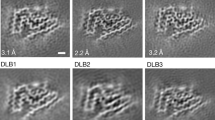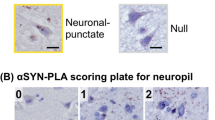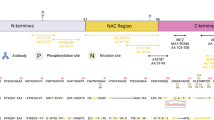Abstract
Lewy bodies (LBs) of idiopathic Parkinson’s disease and glial cytoplasmic inclusions (GCIs) of multiple system atrophy are pathological deposits both composed of phosphorylated α-synuclein woven into different filaments. Although both LBs and GCIs are considered to be hallmarks for each independent synucleinopathy, until now they could not be clearly distinguished on the basis of their biochemical or immunohistochemical features. We have examined possible differences in their argyrophilic features and their relation to synuclein-like or ubiquitin-like immunoreactivity (IR). Pairs of mirror sections from different brain areas were triple-fluorolabeled with an anti-α-synuclein antibody, an anti-ubiquitin antibody and thiazin red (TR), a fluorochrome that labels fibrillary structures such as Lewy bodies or neurofibrillary tangles. One of the paired sections was subsequently stained using the Campbell-Switzer method (CS), and the other by the Gallyas-Braak method (GB). By comparing of the same microscopic field on the paired fluorolabeled sections, subsequently silver-stained with either CS or GB, five different profiles of each structure could be determined: α-synuclein-like IR, ubiquitin-like IR, affinity to TR, argyrophilia with CS or GB. GCIs exhibited argyrophilia with both CS and GB but lacked affinity to TR. In contrast, LBs exhibited argyrophilia with CS but not with GB and some affinity to TR. These disease-specific profiles of argyrophilia were consistent, and were not influenced by areas or cases examined. Although immunohistochemical features of LBs and GCIs were similar in exhibiting IR for α-synuclein and ubiquitin, the contrast in their argyrophilic profiles may indicate possible differences in the molecular composition or conformation of α-synuclein. Even though these empirical differences still remain to be explained, awareness of this clear distinction is potentially of diagnostic and pathological relevance.


Similar content being viewed by others
References
Arima K, Hirai S, Sunohara N, Aoto K, Izumiyama Y, Uéda K, Ikeda K, Kawai M (1999) Cellular co-localization of phosphorylated tau- and NACP/alpha-synuclein-epitopes in Lewy bodies in sporadic Parkinson’s disease and in dementia with Lewy bodies. Brain Res 843:53–61
Braak E, Braak H (1999) Silver staining method for demonstrating Lewy bodies in Parkinson’s disease and argyrophilic oligodendrocytes in multiple system atrophy. J Neurosci Methods 87:111-115
Braak H, Braak E, Ohm TG, Bohl J (1988) Silver impregnation of Alzheimer’s neurofibrillary changes counterstained for basophilic material and lipofuscin pigment. Stain Technol 63:197–200
Campbell SK, Switzer RC, Martin TL (1987) Alzheimer’s plaques and tangles: a controlled and enhanced silver staining method. Soc Neurosci Abstr 13:67
Fujiwara H, Hasegawa M, Dohmae N, Kawashima A, Masliah E, Goldberg MS, Shen J, Takio K, Iwatsubo T (2002) alpha-Synuclein is phosphorylated in synucleinopathy lesions. Nat Cell Biol 4:160–164
Gallyas F (1971) Silver staining of Alzheimer’s neurofibrillary changes by means of physical development. Acta Morphol Acad Scient Hung 19:1–8
Galvin JE, Lee VM, Trojanowski JQ (2001) Synucleinopathies: clinical and pathological implications. Arch Neurol 58:186–190
Gambetti P, Autilio-Gambetti L, Papasozomenos SC (1981) Bodian’s silver method stains neurofilament polypeptides. Science 213:1521–1522
Giasson BI, Forman MS, Higuchi M, Golbe LI, Graves CL, Kotzbauer PT, Trojanowski JQ, Lee VM (2003) Initiation and synergistic fibrillization of tau and alpha-synuclein. Science 300:636–640
Iqbal K, Braak E, Braak H, Zaidi T, Grundke-Iqbal I (1991) A silver impregnation method for labeling both Alzheimer paired helical filaments and their polypeptides separated by sodium dodecyl sulfate-polyacrylamide gel electrophoresis. Neurobiol Aging 12:357–361
Jakes R, Crowther RA, Lee VM, Trojanowski JQ, Iwatsubo T, Goedert M (1999) Epitope mapping of LB509, a monoclonal antibody directed against human alpha-synuclein. Neurosci Lett 269:13–16
Nakazato Y, Yamazaki H, Hirato J, Ishida Y, Yamaguchi H (1990) Oligodendroglial microtubular tangles in olivopontocerebellar atrophy. J Neuropathol Exp Neurol 49:521–530
Papp MI, Kahn JE, Lantos PL (1989) Glial cytoplasmic inclusions in the CNS of patients with multiple system atrophy (striatonigral degeneration, olivopontocerebellar atrophy and Shy-Drager syndrome). J Neurol Sci 94:79–100
Sakamoto M, Uchihara T, Hayashi M, Nakamura A, Kikuchi E, Mizutani T, Mizusawa H, Hirai S (2002) Heterogeneity of nigral and cortical Lewy bodies differentiated by amplified triple-labeling for alpha-synuclein, ubiquitin, and thiazin red. Exp Neurol 177:88–94
Sandmann-Keil D, Braak H, Okochi M, Haass C, Braak E (1999) Alpha-synuclein immunoreactive Lewy bodies and Lewy neurites in Parkinson’s disease are detectable by an advanced silver-staining technique. Acta Neuropathol 98:461–464
Switzer RC III (1993) Silver staining methods: their role in detecting neurotoxicity. Ann NY Acad Sci 679:341–348
Uchihara T, Nakamura A, Yamazaki M, Mori O (2000) Tau-positive neurons in corticobasal degeneration and Alzhemer disease—Distinction by thiazin red and silver impregnation. Acta Neuropathol 100:385–389
Uchihara T, Nakamura A, Yamazaki M, Mori O (2001) Evolution from pretangle neurons to neurofibrillary tangles monitored by thiazin red combined with Gallyas method and double immunofluorescence. Acta Neuropathol 101:535–539
Uchihara T, Nakamura A, Yamazaki M, Mori O, Ikeda K, Tsuchiya K (2001) Different conformation of neuronal tau deposits distinguished by double immunofluorescence with AT8 and thiazin red combined with Gallyas method. Acta Neuropathol 102:462–466
Uchihara T, Ikeda K, Tsuchiya K (2003) Pick body disease and Pick syndrome. Neuropathology 23:318–326
Uchihara T, Shibuya K, Nakamura A, Yagishita S (2005) Silver stains distinguish tau-positive structures in corticobasal degeneration/progressive supranuclear palsy and in Alzheimer’s disease—Comparison between Gallyas and Campbell-Switzer methods. Acta Neuropathol 109:299–305
Uchihara T, Tsuchiya K, Nakamura A, Akiyama H (in press) Argyrophilic grains are not always argyrophilic-Distinction from neurofibrillary tangles of diffuse neurofibrillary tangles with calcification revealed by comparison between Gallyas and Campbell-Switzer methods-. Acta Neuropathol DOI: 10.1007/s00401-005-1031-7
Uchihara T, Tsuchiya K, Nakamura A, Akiyama H (2005) Silver staining profiles distinguish Pick bodies from neurofibrillary tangles of Alzheimer type—Comparison between Gallyas and Campbell-Switzer methods. Acta Neuropathol 109:483–489
Acknowledgements
Supported in part by the grant from the Ministry of Education, Culture, Sports, Science and Technology (grant in aid for scientific research B15300118) to T.U.
Author information
Authors and Affiliations
Corresponding author
Rights and permissions
About this article
Cite this article
Uchihara, T., Nakamura, A., Mochizuki, Y. et al. Silver stainings distinguish Lewy bodies and glial cytoplasmic inclusions: comparison between Gallyas-Braak and Campbell-Switzer methods. Acta Neuropathol 110, 255–260 (2005). https://doi.org/10.1007/s00401-005-1044-2
Received:
Revised:
Accepted:
Published:
Issue Date:
DOI: https://doi.org/10.1007/s00401-005-1044-2




